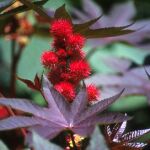| Common Name: |
Castor Bean |
| Other Names: |
Castor Oil Plant, Mexico Seed, Palma-Christi, Wonder Tree, Wunderbaum |
| Botanical Name: |
Ricinus communis |
| Genus: |
Ricinus |
| Family: |
Euphorbaceae |
| Cultivation: |
Well-drained, rich soil in sun. Starved or pot-bound plants tend to flower, rather than producing handsome foliage. Subject to statutory control as a weed in some countries, notably in parts of Australia. |
| Propagation: |
By seed sown in spring at 21°C (70°F). Germination is quicker if seeds are soaked in water for 24 hours prior to sowing. |
| Harvest: |
Ripe seeds are collected and pressed for oil. |
| Native Region: |
NE Africa and W Asia |
| Height: |
1.8m (6ft) as an annual, 10-12m (30-40ft) as an evergreen shrub
Heights for cultivars are for annual growth. |
| Width: |
1-1.2m (3-4ft) as an annual, 4m (12ft) as an evergreen shrub. |
| Varieties: |
Carmencita
Has bronze leaves, bright red female flowers, and red capsules.
Height: 2-3m (6-10ft)
Width: 1m (3ft) |
Impala
Is compact, with maroon foliage, cream-yellow flowers, and maroon capsules.
Height: 1.2m (4ft)
Width: 60-90cm (24-36in) |
Zanzibarensis
Has white-veined green leaves, 50cm (20in) long.
Height: 2-3m (6-10ft) |
|
| Hardiness: |
Z9 |
| Parts Used: |
Seed,Oil, and fat taken from seed. |
| Properties: |
A purgative, emollient herb with an unpleasant taste. |
| Medicinal Uses: |
Internally for constipation and acute diarrhea due to food poisoning. Externally as an enema in severe constipation, and for irritating skin and eye conditions. Used in Ayurvedic medicine for nervous disorders.
To treat constipation, intestinal worms, sore throat, ulcers, joint pain, diarrhea, inflammation of the skin and intestines. |
| Typical Dose: |
A typical dose of castor oil to treat constipation is approximately 15ml. |
| Possible Side Effects: |
Castor oil's side effects include abdominal discomfort, cramps, faintness, and nausea. |
| Drug Interactions: |
| Taking castor oil with these drugs may increase the risk of hypokalemia (low levels of potassium in the blood) |
| Acetazolamide,(Apo-Acetazolamide, Diamox Sequels) |
Azosemide,(Diat) |
Beclomethasone,(Beconase, Vanceril) |
Betamethasone,(Celestone, Diprolene) |
Budesonide,(Entocort, Rhinocort) |
Budesonide and Formoterol,(Symbicort) |
| Bumetanide,(Bumex, Burinex) |
Chlorothiazide,(Diuril) |
Chlorthalidone,(Apo-Chlorthalidone, Thalitone) |
Cortisone,(Cortone) |
Deflazacort,(Calcort, Dezacor) |
Dexamethasone,(Decadron, Dexasone) |
| Digitalis,(Digitek, Lanoxin) |
Ethacrynic Acid,(Edecrin) |
Etozolin,(Elkapin) |
Flunisolide,(AeroBid, Nasarel) |
Fluorometholone,(Eflone, Flarex) |
Fluticasone,(Cutivate, Flonase) |
| Furosemide,(Apo-Furosemide, Lasix) |
Hydrochlorothiazide,(Apo-Hydro, Microzide) |
Hydrocortisone,(Anusol-HC, Locoid) |
Hydroflumethiazide,(Diucardin, Saluron) |
Indapamide,(Lozol, Nu-Indapamide) |
Loteprednol,(Alrex, Lotemax) |
| Mannitol,(Osmitrol, Resectisol) |
Medrysone,(HMS Liquifilm) |
Mefruside,(Baycaron) |
Methazolamide,(Apo-Methazolamide, Neptazine) |
Methyclothiazide,(Aquatensen, Enduron) |
Methylprednisolone,(Depo-Medrol, Medrol) |
| Metolazone,(Mykrox, Zaroxolyn) |
Olmesartan and Hydrochlorothiazide,(Benicar HCT) |
Polythiazide,(Renese) |
Prednisolone,(Inflamase Forte, Pred Forte) |
Prednisone,(Apo-Prednisone, Deltasone) |
Rimexolone,(Vexol) |
| Torsemide,(Demadex) |
Triamcinolone,(Aristocort, Trinasal) |
Trichlormethiazide,(Metatensin, Naqua) |
Urea,(Amino-Cerv, UltraMide) |
Xipamide,(Diurexan, Lumitens) |
| Taking castor oil with these drugs may reduce the absorption of the drug: |
| All drugs taken orally |
| Taking castor oil with these drugs may increase the loss of electrolytes and fluids: |
| Cascara,(Cascara) |
Docusate and Senna,(Peri-Colace, Senokot-S) |
|
| Disease Interactions: |
May worsen cases of Crohn's disease, irritable bowel syndrome, or other gastrointestinal ailments |
| Food Interactions: |
Absorption of castor oil may be decreased if taken within one hour of drinking milk. |
| Supplement Interactions: |
- Increased risk of cardiac glycoside toxicity when used with other herbs that contain cardiac glycosides, such as Black Hellebore, Calotropis, Motherwort, and others.
- Increase risk of potassium depletion when used in conjunction with Horsetail Plant or Licorice
- Increased risk of potassium depletion when used with other stimulant laxative herbs, such as Black Root, Cascara Sagrada, and Senna.
- Enhanced absorption of castor oil when taken with oil-soluble anthelmintic herbs, such as Male Fern.
- May decrease toxicity and efficacy of Wormseed oil when taken concurrently with castor oil.
|
| Culinary Uses: |
Castor oil is used to coat grains and legumes in India. |
| Economic Uses: |
Oil is added to soaps, cosmetics, and ophthalmic products, and used in the making of candles, crayons, varnishes, lubricating oils, high-performance fuels, carbon paper, polyamide fiber, leather preservatives, fabric waterproofing, and dyes for cotton: also in the food industry to give nutty or buttery flavors. Castor oil repels insects, notably cockroaches. Seed residue is used in fertilizers, and in fiber and board manufacture. |
| Warning: |
All parts, especially seeds, are extremely toxic if eaten. Repeated handling of foliage or seeds may cause skin irritation or allergic reactions.
Excess causes severe colic, vomiting, and purgation. |
| Bibliography: |
Encyclopedia of Herbs by Deni Brown Copyright © 1995, 2001 Dorling Kindersley Limited. pp 345-346.
The Essential Herb-Drug-Vitamin Interaction Guide by Geo. T. Grossberg,MD and Barry Fox,PhD. Copyright © 2007 Barry Fox, PhD pp.128-129
|
